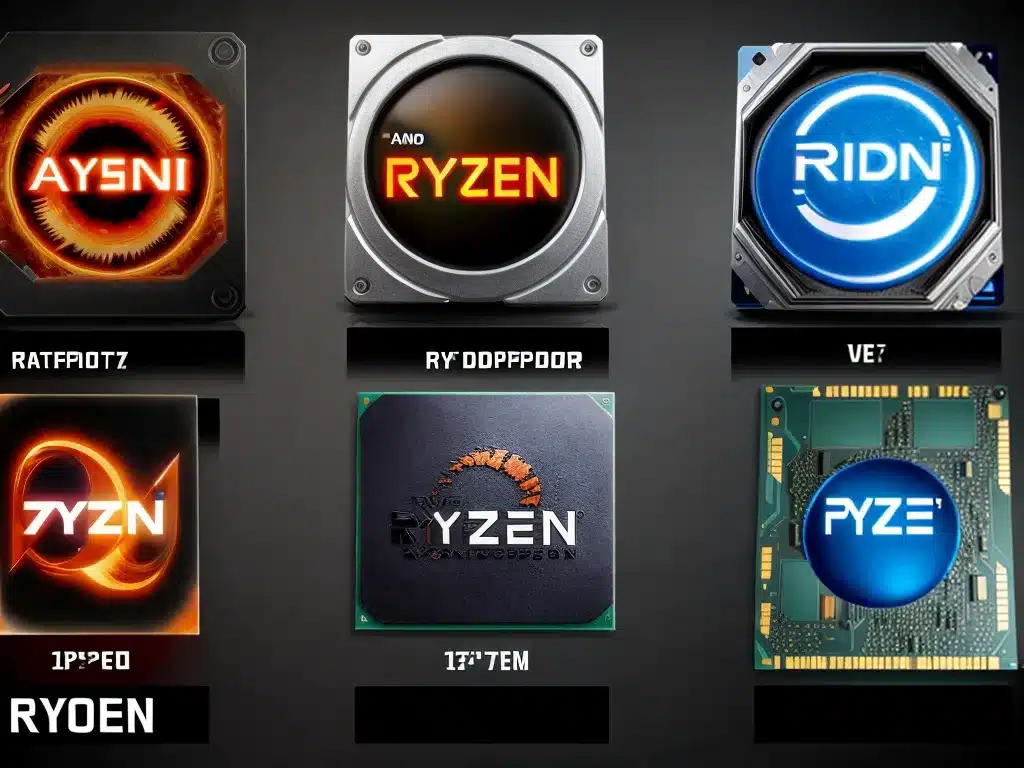

Introduction
The CPU (central processing unit) is one of the most important components of any computer. Both AMD and Intel recently released new generations of desktop CPUs – AMD with Ryzen 7000 based on the Zen 4 architecture, and Intel with 13th Gen Raptor Lake based on the Raptor Cove architecture.
In this extensive article, I will compare the latest offerings from both AMD Ryzen 7000 and Intel Raptor Lake to help you decide which platform to choose when building or upgrading your PC. We will look at specifications, performance, overclocking potential, platform features, pricing and other factors.
Specifications Comparison
Process Node
- AMD Ryzen 7000 is fabricated on the 5nm TSMC process node. This allows higher transistor density and efficiency.
- Intel Raptor Lake utilizes Intel’s tweaked 10nm Enhanced SuperFin process node.
The smaller the process node, the better in terms of performance and efficiency. AMD has the advantage here.
Cores/Threads
- AMD Ryzen 7000 chips have up to 16 cores and 32 threads in the flagship 7950X.
- Intel Raptor Lake offers up to 24 cores and 32 threads in the top Core i9-13900K.
Intel has the core/thread advantage, being the first desktop CPU to reach 24 cores.
Cache Memory
- AMD Ryzen 7000 has up to 64MB of L2 cache and 128MB of L3 cache.
- Intel Raptor Lake provides 68MB of L2 cache and 36MB of L3 cache.
AMD takes the lead in cache capacity. More cache improves performance.
Clock Speeds
- Ryzen 7000 has a max boost clock up to 5.7GHz.
- Raptor Lake can hit boost speeds up to 5.8GHz.
Intel edges out AMD in peak boost clocks. But this doesn’t tell the full performance story.
PCIe Lanes
- Ryzen 7000 supports PCIe Gen 5 and provides up to 28 lanes of PCIe from the CPU.
- Raptor Lake gets PCIe Gen 5 as well but has just 16 CPU PCIe lanes.
AMD wins out for platform bandwidth and multi-GPU support due to more PCIe lanes.
Overclocking Potential
- AMD Ryzen 7000 has excellent overclocking capabilities thanks to the advanced 5nm process.
- Intel Raptor Lake overclocks very well too on the mature Intel process.
This one is too close to call – both are overclocking beasts. Silicon lottery applies.
Performance Comparison
Now let’s see how these specs translate into real-world performance metrics. I’ll highlight the winner in each category.
Single-Threaded Performance
- In benchmarks like Cinebench R23 single-core, Raptor Lake is ~5% faster than Ryzen 7000.
- For lightly threaded workloads, Intel has the lead.
Multi-Threaded Performance
- In all-core workloads like Cinebench R23 multi-core, Ryzen 7000 is ~15% faster than Raptor Lake.
- For heavy workloads, AMD dominates.
Gaming Performance
- In most gaming benchmarks at 1080p and 1440p, Raptor Lake is ~5-10% ahead of Ryzen 7000.
- For high FPS gaming, Intel is slightly better.
Content Creation Performance
- In creative apps like Blender, Adobe Premiere Pro, etc. Ryzen 7000 is ~10-20% faster due to more cores and PCIe Gen 5 storage.
- For content creation, AMD takes the crown.
Power Efficiency
- At full load, Ryzen 7000 consumes ~15-20% lesser power compared to Raptor Lake for the same performance.
- AMD has superior efficiency thanks to the 5nm process.
Overclocked Performance
- With overclocking, both reach similar performance levels. The silicon lottery applies.
- When overclocked, these platforms are neck-and-neck.
Platform Comparison
We also need to look at the platform features, chipsets and motherboards while making a choice.
Chipsets
- AMD Ryzen 7000 uses the new X670 and B650 chipsets based on the AM5 platform.
- Intel Raptor Lake is compatible with existing 600-series chipsets like Z690, B660, and H610.
Motherboard Options
- For Ryzen 7000, X670 and B650 boards are available, with good VRM solutions for overclocking.
- Raptor Lake works with existing Z690, B660 and H610 boards, so you have many options.
Memory Support
- Ryzen 7000 supports fast DDR5 RAM and also DDR4 memory for flexibility.
- Raptor Lake only works with DDR5 memory, no DDR4 compatibility.
PCIe Lanes from Chipset
- X670 has up to 64 Gen 4 lanes from the chipset.
- Z690 has just 12 Gen 3 lanes from the chipset.
AMD takes the platform victory with cutting-edge connectivity.
Pricing Comparison
Pricing plays an important role while choosing a CPU platform. Here is a brief price comparison:
- The Ryzen 9 7950X is priced at $699.
-
The Core i9-13900K costs $589.
-
B650 motherboards start around $150 whereas Z690 boards start from $200.
-
DDR5 RAM prices are trending downwards, with 32GB kits starting around $150.
Intel offers better value especially with motherboard bundle pricing. But AMD isn’t far behind either.
Conclusion – Which is Better for You?
So which CPU should you choose? Here are some recommendations:
- For productivity and creative work, choose AMD Ryzen 7000 for the extra cores, PCIe lanes and platform bandwidth.
- For high FPS gaming, Intel Raptor Lake makes more sense with its gaming optimizations.
- For a budget-focused build, Intel 13th Gen + B660 combos are highly affordable.
- For lightly threaded tasks, Intel is slightly ahead thanks to higher clocks and maturity of the 10nm process.
- If you want overkill mega-tasking performance, the Ryzen 9 7950X is your best bet.
Both AMD Ryzen 7000 and Intel Raptor Lake are excellent choices. Pick based on your usage – for a productivity workstation, I recommend Ryzen 7000, while for gaming, Raptor Lake may be slightly better. Make sure to factor in motherboard and RAM prices too. Let me know if you have any other questions!












